
|
<-- February March Annual Meeting -->
Update - We will have two categories to vote on. Select one from each category.
Special & rare plants of NJ
Native perennials for your backyard habitat
Swamp Pink, Helonias bullata
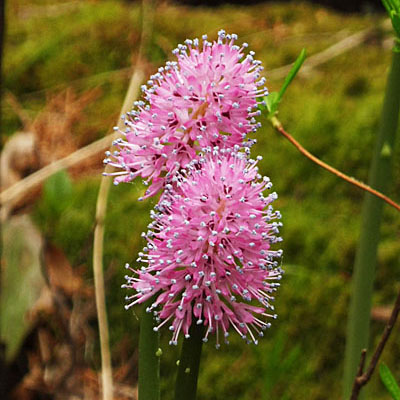 Swamp pink, a federally threatened species, characterized by bright pink flower clusters that bloom in early spring, is one of the most beautiful wildflowers in the eastern United States. Swamp pink, a perennial, has smooth, evergreen, lance-shaped leaves approximately 3 to 10 inches long that lie flat on the ground in a basal rosette. The stocky, hollow flower stem grows from 1 to 3 feet tall. In April or early May, the stem is topped by a cluster of pink flowers dotted with pale blue anthers. By late May, the stem turns light brown, and the dried flowers release their seeds by mid-June. The evergreen leaves of swamp pink make it easy to identify year-round—if you are lucky or intrepid enough to venture into its wetland habitat to find it. Since the species needs shade to survive, it is limited to shady, forested wetlands in association with Atlantic white cedar (Chamaecypa tisthyoides), red maple (Acer rubrum), sweet pepperbush (Clethra alnifolia), sweetbay magnolia (Magnolia virginiana), sphagnum moss (Sphagnum spp.), cinnamon fern (Osmunda cinnamomea), skunk cabbage (Symplocarpus foetidus), and laurels (Kalmia spp.). Swamp pink often grows on hummocks formed by trees, shrubs, and sphagnum moss in forested wetlands.
Swamp pink, a federally threatened species, characterized by bright pink flower clusters that bloom in early spring, is one of the most beautiful wildflowers in the eastern United States. Swamp pink, a perennial, has smooth, evergreen, lance-shaped leaves approximately 3 to 10 inches long that lie flat on the ground in a basal rosette. The stocky, hollow flower stem grows from 1 to 3 feet tall. In April or early May, the stem is topped by a cluster of pink flowers dotted with pale blue anthers. By late May, the stem turns light brown, and the dried flowers release their seeds by mid-June. The evergreen leaves of swamp pink make it easy to identify year-round—if you are lucky or intrepid enough to venture into its wetland habitat to find it. Since the species needs shade to survive, it is limited to shady, forested wetlands in association with Atlantic white cedar (Chamaecypa tisthyoides), red maple (Acer rubrum), sweet pepperbush (Clethra alnifolia), sweetbay magnolia (Magnolia virginiana), sphagnum moss (Sphagnum spp.), cinnamon fern (Osmunda cinnamomea), skunk cabbage (Symplocarpus foetidus), and laurels (Kalmia spp.). Swamp pink often grows on hummocks formed by trees, shrubs, and sphagnum moss in forested wetlands.
(Photo: Millie & Hubert Ling, Pine Barrens, NJ)
Bog Asphodel, Narthecium americanum
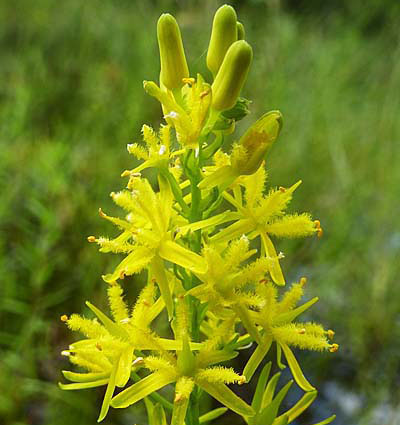 Also known as Yellow Asphodel, Bog Asphodel is a globally rare perennial plant of sandy acid bogs and swamps. Although once found in a few small, scattered populations from South Carolina to New Jersey, it is now only found in the New Jersey Pine Barrens (Atlantic, Burlington, Gloucester, and Ocean Counties). The fabulous bright yellow flowers are borne on dense 2.5" spikes rising 1 to 1.5' above a cluster of narrow basal grass-like leaves in June and July. It grows in part shade, seeming to prefer sites where there is a break in the overhead canopy. It is sensitive to both flooding and drying, and only thrives where there is water movement near the surface of the soil. The main pollinator of this plant appears to be the native Brown Bee (Evylaeus truncatus). This plant continues to become increasingly rare in NJ due to loss of habitat, poaching, and habitat destruction.
Also known as Yellow Asphodel, Bog Asphodel is a globally rare perennial plant of sandy acid bogs and swamps. Although once found in a few small, scattered populations from South Carolina to New Jersey, it is now only found in the New Jersey Pine Barrens (Atlantic, Burlington, Gloucester, and Ocean Counties). The fabulous bright yellow flowers are borne on dense 2.5" spikes rising 1 to 1.5' above a cluster of narrow basal grass-like leaves in June and July. It grows in part shade, seeming to prefer sites where there is a break in the overhead canopy. It is sensitive to both flooding and drying, and only thrives where there is water movement near the surface of the soil. The main pollinator of this plant appears to be the native Brown Bee (Evylaeus truncatus). This plant continues to become increasingly rare in NJ due to loss of habitat, poaching, and habitat destruction.
(Photo: Millie & Hubert Ling, Pine Barrens, NJ)
More information about Bog Asphodel
Rock Harlequin, Corydalis sempervirens
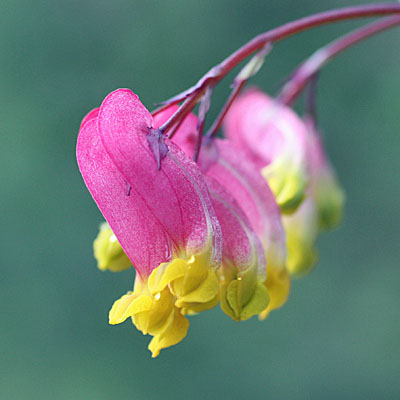 This delicate-looking plant of evergreen-shaded rock faces is considered to be an early successional species and often grows in fire-disturbed areas. A biennial, it typically grows in association with red cedar (Juniperus virginiana) and other early successional tree species in dry, rocky, acidic areas. The plant grows about 8 to 30 inches tall, although first-year plants produce only a basal rosette of leaves. In the second year, the plants send up many branched stems, topped by clusters of lovely pink-and-yellow tubular flowers, followed by long, narrow seed pods. The leaves resemble those of our native columbine, Aquilegia canadensis, glaucous and deeply divided. The species is native across Canada, throughout the upper Midwest and New England, and in the Appalachians as far south as northern Georgia. Conservation status in New Jersey is SNR (not yet determined).
This delicate-looking plant of evergreen-shaded rock faces is considered to be an early successional species and often grows in fire-disturbed areas. A biennial, it typically grows in association with red cedar (Juniperus virginiana) and other early successional tree species in dry, rocky, acidic areas. The plant grows about 8 to 30 inches tall, although first-year plants produce only a basal rosette of leaves. In the second year, the plants send up many branched stems, topped by clusters of lovely pink-and-yellow tubular flowers, followed by long, narrow seed pods. The leaves resemble those of our native columbine, Aquilegia canadensis, glaucous and deeply divided. The species is native across Canada, throughout the upper Midwest and New England, and in the Appalachians as far south as northern Georgia. Conservation status in New Jersey is SNR (not yet determined).
(Photo: Millie & Hubert Ling)
Downy Serviceberry Amelanchier arborea
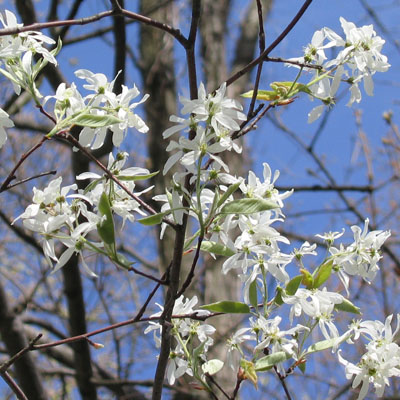 Snow in spring is how some folks describe this small tree. The tree's early white to pinkish-white blooms stand in stark contrast to a barren winter landscape. The five-petaled fragrant flowers occurring in racemes appear before the leaves unfold. By June the flowers give way to green then ripen to purplish-black berries. By early summer, Downy Serviceberry has provided a smorgasbord of nectar and pollen to early bees and butterflies and sweet berries to birds of many types. In fall it offers golden to rust and red foliage. A deciduous multi-stemmed tree, native to New Jersey and the Northeast into Canada, it can achieve 25' in height with suckering that can expand its width to 30'. It's a versatile plant doing well in full sun to partial shade and acidic to neutral, sandy, loam, or clay soil that is moist and well drained, but occasionally wet or dry. Closely related are A.canadense a shrubby version of the genera and A.laeve is a hairless small tree that's hard to distinguish from A.arborea which has fine hairs on its leaves and twigs in spring. All Amelanchier genera are great replacements for Bradford Pear a non-native species classified as invasive.
Snow in spring is how some folks describe this small tree. The tree's early white to pinkish-white blooms stand in stark contrast to a barren winter landscape. The five-petaled fragrant flowers occurring in racemes appear before the leaves unfold. By June the flowers give way to green then ripen to purplish-black berries. By early summer, Downy Serviceberry has provided a smorgasbord of nectar and pollen to early bees and butterflies and sweet berries to birds of many types. In fall it offers golden to rust and red foliage. A deciduous multi-stemmed tree, native to New Jersey and the Northeast into Canada, it can achieve 25' in height with suckering that can expand its width to 30'. It's a versatile plant doing well in full sun to partial shade and acidic to neutral, sandy, loam, or clay soil that is moist and well drained, but occasionally wet or dry. Closely related are A.canadense a shrubby version of the genera and A.laeve is a hairless small tree that's hard to distinguish from A.arborea which has fine hairs on its leaves and twigs in spring. All Amelanchier genera are great replacements for Bradford Pear a non-native species classified as invasive.
(Photo: Hubert & Millie Ling )
Great Blue Lobelia Lobelia siphilitica
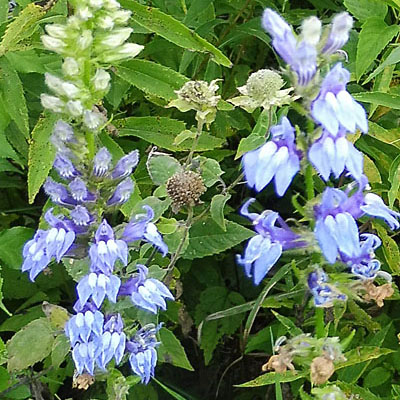 Great blue lobelia is showy and long blooming. Its hue of blue in late summer hints of cooler days ahead. This bright blue counterpart to our red Cardinal flower is equally loved by hummingbirds, butterflies, and bees alike. Flowers reach from the upper leaf axils forming a dense terminal raceme 2-3' tall. The flowers are lavender blue and tubular with 2-lips; the three lobes of the lower lip appear more prominent than the two-lobed upper lip. This is a clump forming perennial that will happily seed around your garden and in optimal conditions reach 4' tall. It prefers full or near full sun with wet feet yet tolerates consistently moist soils when accompanied by midday and afternoon shade. The Iroquois tribe touted its many medicinal uses, including curing venereal disease from which its species name is derived.
Great blue lobelia is showy and long blooming. Its hue of blue in late summer hints of cooler days ahead. This bright blue counterpart to our red Cardinal flower is equally loved by hummingbirds, butterflies, and bees alike. Flowers reach from the upper leaf axils forming a dense terminal raceme 2-3' tall. The flowers are lavender blue and tubular with 2-lips; the three lobes of the lower lip appear more prominent than the two-lobed upper lip. This is a clump forming perennial that will happily seed around your garden and in optimal conditions reach 4' tall. It prefers full or near full sun with wet feet yet tolerates consistently moist soils when accompanied by midday and afternoon shade. The Iroquois tribe touted its many medicinal uses, including curing venereal disease from which its species name is derived.
(Photo: Hubert & Millie Ling, White Lake, Sussex County)
Common Buttonbush Cephalanthus occidentalis
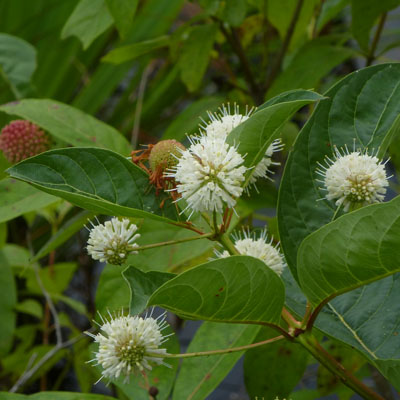 Gumballs growing on trees, how unusual? Borne on a long stalk, the flowering sphere consists of numerous clustered tiny, tubular, 5-lobed white, fragrant flowers. The long style gives the flowers of Buttonbush a pin cushion look. The shrub blooms in early to mid-summer. By summers' end into fall the spheres are hardened into reddish brown hard nutlets eaten by waterfowl. A multi-stem shrub, it grows to 6-12' that can be pruned to avoid a course look. One of the last native shrubs to leaf out, the glossy green leaves unfold providing food for the larval stage of the large, showy hydrangea sphinx and titan sphinx moths. The shrub itself is a pollinator magnet so much so that in 1735 the shrub was put into commercial production for beekeepers. Buttonbush requires full sun to partial shade in moist to wet soils. It is not drought proof and will require watering in dry sunny areas. For garden purposes, there are several cultivars available if size is a concern or brilliant fall color is your desire.
Gumballs growing on trees, how unusual? Borne on a long stalk, the flowering sphere consists of numerous clustered tiny, tubular, 5-lobed white, fragrant flowers. The long style gives the flowers of Buttonbush a pin cushion look. The shrub blooms in early to mid-summer. By summers' end into fall the spheres are hardened into reddish brown hard nutlets eaten by waterfowl. A multi-stem shrub, it grows to 6-12' that can be pruned to avoid a course look. One of the last native shrubs to leaf out, the glossy green leaves unfold providing food for the larval stage of the large, showy hydrangea sphinx and titan sphinx moths. The shrub itself is a pollinator magnet so much so that in 1735 the shrub was put into commercial production for beekeepers. Buttonbush requires full sun to partial shade in moist to wet soils. It is not drought proof and will require watering in dry sunny areas. For garden purposes, there are several cultivars available if size is a concern or brilliant fall color is your desire.
(Photo:Hubert & Millie Ling Wawayanda State Park, Sussex county)